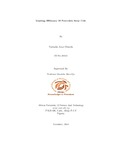| dc.description.abstract | The power conversion efficiency of perovskite solar cells has risen from as low as 3.8% to as high as 19.3% in just five years with yet a projected value of over 20% in the next few years by experimentalists. Such a tremendous breakthrough is one of its kind in photo-voltaic research with thin film solar cells as the only major competitor. The light harvesting layer in these new devices has a crystalline structure called the perovskite structure which is capable of absorbing photons in both the visible and near infra-red regions of the solar radiation spectrum. In this study, we carried out theoretical studies based on the detailed balance theory originally proposed by Shockley and Queisser, and on a semi-emperical approach based on measured optical absorption spectrum of the three most widely used perovskite absorbers: CH 3 NH 3 SnI 3 , CH 3 NH 3 PbI 3 , and CH 3 NH 3 PbI 3-x Cl x . We arrived at an upper conversion efficiency limit for a single planar hetero-junction(PHJ) perovskite solar cell with anti-reflection capabilities considering radiative losses as the only carrier loss mechanism within the cell. The limiting efficiency was found to be 29.2% for CH 3 NH 3 PbI 3 , 27.5% for CH 3 NH 3 PbI 3-x Cl x , and 24.8% for CH 3 NH 3 SnI 3 under AM1.5 solar spectrum. Issues such as the effect of exciton diffusion length and absorber thickness on the efficiency
are also discussed. | en_US |

